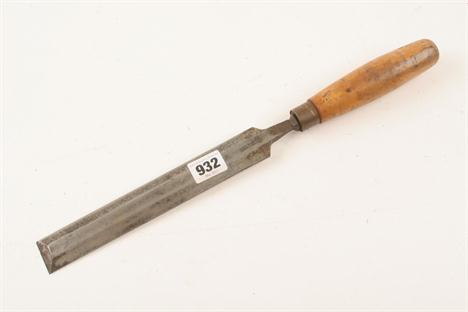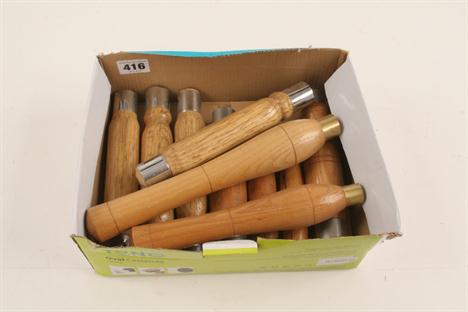We found 1902 price guide item(s) matching your search
There are 1902 lots that match your search criteria. Subscribe now to get instant access to the full price guide service.
Click here to subscribe- List
- Grid
-
1902 item(s)/page
A COLLECTION OF WOODWORKING TOOLS including thirty-five boxwood handled and eleven beech handled chisels and gauges by William Marples & Sons, C F Johnson, Isaac Sorby, Ward, J B Addis & Sons, C Hill and others, the handles all stamped with the owner`s name S C MASON, English and American iron and steel planes including Stanley Rule & Level Co 113 circular plane and 78 Duplex rabbet plane, Bailey No 5 jack plane and No 8 jointer plane and Record 3 in 1 chisel and shoulder plane, three hand saws, one by Diston and miscellaneous other tools, including squares, brace, rules, etc in black painted mahogany tool chest with various original photographs, silver fob shields, etc Provenance: The tools of the trade of Stanley Charles Mason (1903-1980) pattern maker of Chesterfield, Derbyshire. Mr Mason was apprenticed pattern maker at Markham & Co where he was employed for many years before working with his employer`s agreement for Plowright Bros.
A George III ebonised tavern wall timepiece Unsigned, circa 1800 The four pillar single train weight-driven eight-day movement with large greatwheel for the four wheel train, anchor escapement and tapered plates, the 16 inch wooden convex gilt on black Roman numeral dial with gilt spade hands and slender moulded edge, the drop-trunk case with side doors above long concave-topped rectangular door to front and `chisel` foot, (case redecorated), 132cm (52ins) high
Karl Brandner January oil on masonite Karl Brandner (American, 1898-1961) "January," c. 1920, oil on masonite, 20" x 24", signed lower right, Chicago Galleries Association (Chicago, Illinois) label on verso, The Palette and Chisel Academy of Fine Arts (Chicago, Illinois) label on verso, framed no retouch; loss to board along upper edge; otherwise in good condition Starting Price: $250
BOGOLIUBOV, ALEXEI(1824-1896)View of the Venetian Lagoon from the Public Gardens, signed.Oil on canvas, 71.5 by 120 cm.Executed in the 1870s. Provenance: Galerie Laurencie, Geneva. Acquired from the above by the Swiss diplomat Henri Coursier, c. 1975. Thence by descent to the previous owner. Private collection, Europe. Authenticity certificate from the expert V. Petrov.Alexei Bogoliubov visited Venice three times in the course of his long career – in the autumn of 1854, winter and spring of 1863 and, lastly, in the February of 1872. View of the Venetian Lagoon from the Public Gardens was in all probability painted from an impression left by this last visit. The image of this wonderful island city captured Bogoliubov’s imagination when still a student at the Imperial Academy of Arts, where he would copy engraved vedute and his teacher Maxim Vorobiev’s Venetian sketches. Nevertheless, arriving in Venice in October 1854 after a long journey through Europe, Bogoliubov was completely overwhelmed by his new surroundings. He was later to recall: “Dressing quickly, I ran out into the narrow street, weaved left and right managing to emerge, more by luck than judgement, on St Mark’s Square,where I stood at length gaping in astonishment. I wandered around the square for about an hour looking now at the piazzetta, now the entrance to the Palazzo Ducale, then the cathedral doors, stopping over nothing... Thus, on the first day, I bowled along like a hoop, scooting from one view to another. The warm Venetian evening came and a full moon floated up as though by design; night fell like a curtain and suddenly Venice appealed even more. The black gondolas striped silver across the surface of the Grand Canal and lagoon. Everything seemed covered in a fine, pale-bluish gauze. I jumped into a public gondola and was taken to Custom House. There I sat for a long while on the marble steps, only setting off to dine at 10 in the evening... My first sketch was the waterfront — with the Doge’s palace in the foreground. It was difficult — very difficult — not only to paint but to sketch the details of this intricate building. Nowadays, I would restrict myself to sketching the perspective and dimensions of the building and take the details from a photograph. But in those days photography had only just replaced daguerreotype and the best local photographer was selling views at a hundred francs per copy and more, which was completely beyond my means. This is why I used my pen to chisel out every column, capital and cornice on the palaces and the buildings, doing the drawings in folio, which in no small way taught me how to make loose, natural drawings of architecture, for which I had always had a passion. There are 400 examples of these drawings which can be seen the Academy of Arts. Then I made studies of the church with the canal, and travelled to the Lido to paint the sea. I painted several views of Venice from the public gardens. I worked tirelessly for two months”. These recollections record with surprising accuracy Bogoliubov’s favourite views of Venice. One of the artist’s favourite viewpoints was of the lagoon seen from the public gardens, of which this landscape is a variation. The perspective has been altered somewhat to allow him to capture the magnificent panorama, from San Giorgio Maggiore and the church of Santa Maria Salute to the Schiavoni embankment. The warm lilac-grey, blue and gold tints of this canvas recreate the feel of a calm Italian morning and involuntarily convey that rapture with which Russian landscapists from Sylvester Shchedrin to Ivan Aivazovsky handled their depictions of Venice."
Heading !!!!!!! The following four planes are all stamped C Payne. These planes were purchased together from a gentleman in Plymouth c1980 who had inherited them from a relative, C Payne, who had worked as a plane maker in the Norris factory, apparently, the chisel plane was made by him during his time at Norris, perhaps a prototype. A probably unused 20 1/2" d/t steel NORRIS A1 jointer with rosewood infill and handle still with orig grease (illustrated Russell fig 1281) G++
**A MISCELLANEOUS GROUP OF SIX BRONZE AND IRON IMPLEMENTS, FIRST MILLENIUM BC AND LATERcomprising an iron sickle blade, Europe, 16th century or earlier, of crescent shaped form with integral ring socket, a Roman bronze strigil, 1st-2nd century AD, an Indian bronze elephant goad blade (ankus), probably 15th/16th century, a bronze tool, with flared chisel blades at either end, possibly Roman, and two serpentine knife blades, one iron, the other bronze, probably Iberia, 1st millennium BC45 cm; 17 3/4 in and smaller(6)ProvenanceThe fourth: Comtesse de Broussiere, until circa 1913, said to have been found by her father Julian Greau, in the Rhone Valley towards the end of 19th century, Karl Freund (Anderson Galleries), 16th May 1928The last: Note on the old file card states: "Purchased from the store room of the Egyptian collection of the Metropolitan Museum of Art in New York, September 1, 1958, by Richard C. Higgins and present [sic] to JWHA. their gift catalogue number, 219". A later record states that no records have been found at the Metropolitan Museum to verify this statement.JWHA Inv. Nos. 238.25, 238.14, 299, 553, 3154, 285
English School (19th century) Portrait of a female sculptor, probably Rosa Bonheur, half length, wearing a dark brown robe with fur collar, black coat and open necked white chemise, holding a chisel, her other hand resting upon a marble bust oil on canvas, old stencil painted Christies stock no. verso `CE278` 39 x 29in. (99 x 73.5cm.)
[HEPWORTH (Barbara)] TOFT (Albert) Modelling and Sculpture, Seeley Service & Co [no date], inscribed in ink to first free end paper ‘Barbara Hepworth Leeds 1922’, and with brief household accounts to rear paste-down including ‘[£]1-9 for a chisel (from H.M.)’ [possibly Henry Moore]), slightly faded/worn cloth, lower edge slightly paint spotted
A Drew & Sons, Piccadilly Circus, London Silver Mounted Folding Pocket Knife, the steel frame with silver grip scales hallmarked for Sheffield 1898 and engraved with initials A.R-G, set with a hoof pick, corkscrew, screw pin, button hook, tapering triangular bradawl, two graduating knife blades and a file/chisel
A seventeenth century style oak wainscot chair, the back carved with lion & unicorn crest flanked by rose & thistle with similar panel below depicting birds, cornucopia, fruit, leaves and insects flanking a sun, the back surmounted by fluted ball finials having downswept arms carved in a similar manner, supported on fluted columns with solid seat raised on turned legs with moulded chisel carved stretchers.
A Victorian mahogany domestic wall regulator. Unsigned, late 19th century. The four pillar movement with deadbeat escapement, Harrison’s maintaining power and invar rod pendulum with cylindrical tall alloy bob incorporating brass compensation tube, the 14 inch circular cream painted Roman numeral dial with subsidiary seconds dial and bearing inscription QUEENS COLLEGE, CAMBRIDGE to centre, with steel spade hands and cast brass bevel-glazed bezel with canted inner edge, the case with circular moulded dial surround to hood above concave moulding with plain frieze to throat and bevel-glazed rectangular caddy moulded door flanked by canted angles to trunk, the chisel-shaped foot with applied rectangular panel decoration, 173cm (68ins) high.
LB&SCR 14" oak cased drop dial chisel bottom fusee Clock No 1173B. The chain driven fusee movement appears to be in working order but has not been tested. The back of the plate is stamped `GBE` and the oak case is complete with its original cast bezel with the back of the box stamped `1173 B`. The pendulum bob is also stamped `1173`. The dial has been painted but would benefit from a repaint. Most of the original lettering, including 1173 B, is still discernible. The SR clock records show that this clock was originally supplied for use at London Bridge station and was then transferred to the CME department at Ashford (Kent). A nice example that would benefit from sympathetic restoration.
A Great Western Railway (later British Railways) mahogany drop-dial wall clock, by Skarratt of Worcester, the 12-inch circular cream painted dial with black Roman numerals, with a four pillar single fusee movement, the case with a chisel base, the interior with applied plaque "B.R - W.R / 4972", complete with pendulum and key, 65cm high.
-
1902 item(s)/page



























![[HEPWORTH (Barbara)] TOFT (Albert) Modelling and Sculpture, Seeley Service & Co [no date], inscribed in ink to first free](http://lot-images.atgmedia.com/SR/10091/2873198/171-201329102111_468x382.jpg)





























